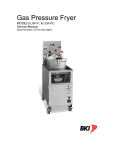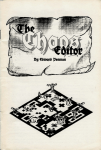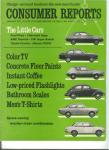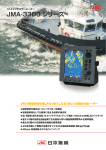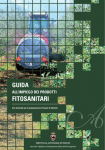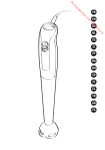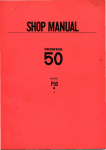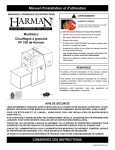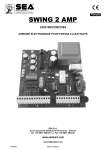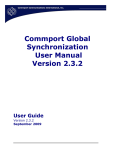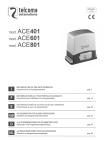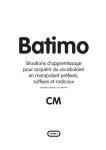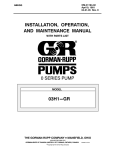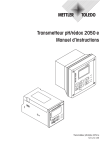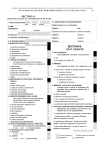Download n~wsl - American Bonanza Society
Transcript
n~wsl
BONANZA OF THE MONTH
This month our outstanding Bonanza
is owned by the people who at one
tim e have had all the Bonanzas of the
Month - th e Beech Factory . Thi s
month they are introduci ng the latest
version of the turbocharged Model 36 ,
the B36TC .
Beech has made some impressive
changes in th is airplane . Firs t of all.
they have Increased th e win g span
4'4" , to 3 7' 10", Thi s wing span
inc rease coupled with the use o f th e
Model 58 Baron win g spar and
ca rry-thru section allows for a gross
weight increase of 200 Ibs, to 3,850
Ibs and an inc rease in useful load of
140 Ibs, to 1,528 Ibs. Pilot r eports
indica te that the longer wing improves
both slow fl ight and stall
characteri stics. Vort ex generators have
been added to the lead ing edge of the
wing to comply with FAA spin recovery
requiremen ts.
In addition th e useable fu el capacity
has been Inc reased by 28 gallons, to
102 gallons. Thi s is done by going to a
BONANZA SERVICE CLINIC
SCHEDULE
THE 1982 SCHEDULE FOR THE
BONANZA SERVICE CLIN ICS HAS
BEEN SET UP:
Baton Rouge, Louisiana March 26 - 29, 1982
Bakersfi eld , California April 16- 19, 1982
Jacksonville, Fl orida May 14 - 18, 1982
Colorado Springs, Colorado June 4 - 8, 1982
Oshkosh, Wi sconsin June 25 - 29, 1962
Woodland , California July 23 - 26 , 1982
Bedford , Massachuse tt s Sept ember 17 - 20 , 1982
Oneonta, New York September 22 - 24 , 1982
This extremely popul ar program is
conduc ted by Norm Colvin , retired
Bonanza Service Engineer fo r Beech ,
and now ABS Technical Consultant. Mr.
Colvi n inspec ts the owner's airplane
and gives him a report as to general
condition and special areas that might
need attention. All owners are
encouraged to be with Norm during th e
clini c, as it is quite educationaL Cost of
th e clinic is $60 .
Registration form s for both th e
Refresher Seminar or the Se rvice Clinic
can be found in thi s issue's Ad-Mart .
page 1154
system of two interconnecting bl adders
in the leading edge, similar to that used
in several models of the Baron.
Unfortun ately, Ihis installation prec ludes
the use of in-th e-wing radar: so Rya n
Storm Scopes will be a popul ar option,
and somebody will probably STC a Pod
antenna.
With full fuel th ere is a payload
ca pacity of over 900 Ibs. At economy
crui se the B-36TC has a range of
1,124 nautical miles (1,293 statu e
miles) with IFA r eserves. Maximum
speed is 2 13 knots; rate-at-climb is
1.049' per minute, wi th a service
ceiling above 25,000' .
List base price is $ 15 1,350; but
wh en aU the goodies are put in, most
wi ll probabl y roll out th e door at
$ 200,000, plus.
AII-in-a ll , th e top-of-the-line Bonanza
is OUITE IMPRESSIVE.
1982 BONANZA REFRESHER SEMINAR
The Bonanza Refresher Seminar, a ground school progr am designed to help
Bonanza pilots and instru ctors in safety and efficiency , has established its 1982
schedule. tt is as follows:
Denve r, Colorado March 27 - 28 , 1982
San Jose, California April 17 - 18 , 1982
Costa Mesa , Cali fornia April 24 - 25, 198 2
Fort Lauderdale, Florida May 15 - 16, 1982
Tampa, Florid a May 22 - 23, 1982
Portl and , Oregon June 26 - 27 , 1982
Dallas, TexasSept ember 25 - 26, 1982
San Diego, Californ ia October 2 - 3 , 1982
Washington, DC November 13 - 14 , 1982
Detro it, Michiga n November 20 - 2 1, 1982
Cost of the program is $75 and incl udes all materials.
1982 CHAPTER CALENDAR _ _ _ _ _ _ _ _ _ _ _ _ __
SOUTHEAST CHAPTER
March 12 thru March 14 - Cypress
Gardens, Florida
May 14 thru May 16 Jacksonville / St. Augustin e, Florida
(coincides with ABS Service Clinic)
CONTACT: CHARLIE GIBBS, PO Box
10363, Jacksonvi lle, Florid a 32207 ,
904 / 398-200 2
NORTH CENTRAL CHAPTER
May 2 1 thru May 22 - Barkl ey
Lake Lodge, Kentucky
June 25 thru June 27 - Oshkosh ,
Wi sconsin (coi ncides with AB S Service
Clinic, also EAA Museum Tour
Oc tober 1 thru Oc tober 3 - Boyne
Hig hlands, Michigan, day trip to
Mack inac Island
CONTACT: DAVE MICHAELS, 23601
Outwood Drive, Southfield , Michigan
480 34,313 / 356-432 6
NORTHEAST CHAPTER
No events pl anned
WESTERN CHAPTER
April 2 1 thru April 25 - Bu chanan
Field , Conc ord , Californ ia
September (date to be announced)
- Portland , Oregon
CONTACT: ALDEN BARRIOS, 14 36
Muirlands Drive, LaJolla, California
9203 7, 714 / 4 59-590 1
SOUTHWEST CHAPTER
March 26 th ru March 28 - Baton
Rouge, Louisiana Fly-In (coincides with
ABS Service Clinic)
June 13 thru June 20 - Canadian
Trip, Montreal , Quebec , Ottawa and
oth er points of interest
CONTACT: BILL MURMER , 7405
Airport Boulevard . Houston, Texas
7706 1, 71 3 / 64 3-2697
ROCKY MOUNTAIN CHAPTER
Last week in March - Caribbean
Air Tour
June 4 thru June 6 - Colorado
Springs Fl y-In (coincides with ABS
Servi ce Clinic
CONTACT: LEE LAR SON, 10458
Pearl Way, Northglenn , Colorado
80233, 303 / 452-84 79
CRACKED " HEAVY" CASES?
There have been re ports and an art icle
in Avia tion Consumer concerni ng
cracking problems with the fourth
generati on, so ca lled " heavy " case on
th e 10 520.
Any member who has had a crack
develop on a " heavy " case is asked to
drop ABS a not e.
american bon anza society
LOGO CONTEST
The ABS is looking for an " official"
•
logo to be used on the Newsletter , the
building , stationary , patches, deca ls,
etc. Th e Executive Director has about
broke n down trying to figure a d esi gn
that has all three Bonanzas in it - 33,
I
ASS ATIS
This sho uld be an espec ia lly inte resting
inc lud es the M ode l 33 . So fa r, no th ing
35, 36 . Now, the members ca n have
their chance .
For inspiration the new Rocky
Mountain Chapter logo is displayed
below. Use it for inspiration , but pl ease
edition of th e ABS Newsletter with
Beech announci ng a new model
look s right ; any suggesti9ns would be
don't co py - orig inality co unts.
The rul es are simple:
1) Entries can be hand drawn or
type of in-d epth a rti c le . The respo nse
fro m membe rs w ith info rm ati on to
in any other form th at conveys th e idea.
2 ) In case o f simila r design s,
Bo nanza, the 8 3 6TC , and the first
installment of the series on tip tanks. If
well received, we will continue with th is
contribute has been excellent , and I
th ank all of you who took th e time to
write o r ca ll.
earliest postmark decides.
3) All entries must be submitted to
ABS headquarters by May 31, 1982.
The ABS will select the five best
entries and submit them to the Board of
I hope everyone had a c hance to read
th e article on Bonanzas that appeared
in the Ma rc h issue o f FLYING . Dic k
Collins spoke very hig hl y of the Society
and, in particular, raved about Norm
Directors for a vote. Th e winne r will
Colv in . It is hea rtening to see No rm get
th e recogn itio n in th e med ia he so
recei ve a FREE BONANZA ... desk
model (value $150).
MOUNTAIN
>-
~
~
•
I
::::
C'l
.
.6.
~
ri chly deserves. Norm 's knowledge and
dedicatio n a re tremendo us assets to th e
Society and its me mbers.
Members seem to like the new format
apprec iated .
Th e saying goes that " in the spring a
young man 's fancy turns towards
romance " ; well , in the spring a ro und
th e ASS o ffice o ur fa ncy turn s tow ards
the ASS Conventio n . The April issue
w ill have the official ann o un ce me nt of
our annua l Con ventio n in Orla ndo,
Flo rida, Aug ust 18 thru Aug ust 22 ,
1982. But, let me throw in one little
tease r right now . Your Assoc iate
Directo r , Jim Starg el, has arranged fo r
membe rs wh o are interested in gettin g
their seaplan e rating to do so at a very
attrac tive price . With all th e other
programs th at are bein g pl ann ed , th is
will be a Co nve ntion you wo n 't want to
mi ss!
Lets all of us be ca reful up th ere.
of th e Newsletter. We are still trying to
John Frank , Jr.
come up w ith a m asthead d esign th at
Exec utive Director
- ~
~~
,.~>-....
I:
gJ
AME RICAN BONAN ZA SOCIETY NEWSLETTER
(l SSN 0 16 1·3545)
publi shed by
AMERIC AN BONANZ A SOC tETY
A New York Non·Pro m Corpo,.Uon. Organized J anuary, 1961
Publication Office
Mid·Contlnent Airport . PO Boa 12888. Wic hita. Kan... 61211
John M. Fr ank . Jr.
EaacuUve Dir eetor and Ed itor
BOARD OF DIRECTORS
!!!
g
~
BONANZA
Term
WINSLOW FILTERS
Does any member kn ow a so urce for
filter ele ments fo r Winslow Oil Filter
Systems? If so pl ease let ABS
Headquarters know.
ACCIDENT REPORTS
The pilot was killed when a Beech
Baron, N10VS, crashed Jan . 3 during
an in strument approach to Pinehurst ,
N.C. Th e plane missed the first
approach and c rashed o n the seco nd .
The wrec kag e was loc ated six miles
south of Carthage, N.C. The flight had
originated in Fulton County Georgi a.
I
SELECTOR VALVE ACCESS
DOOR
•
Want to put a wing-type fastener on
the selector valve access door or
reptace one that has fallen out? Clay
Collier, ABS #4496 , sends along th e
following part numbers you 'll need:
1) WL-98293-1 -060 Wing Stud
2) 130177-2 Pin
american bonanza society
E M Anderson. Jr • Presldenl
401 HIghland OlI ve. Ke"vllle. TX 78028
John 0 Phelan. VICe Preslde'"
307 WOOdland Lane. Cru mel. IN 46032
Richard Ii Healh. Treasu rer
11 950 2 1s1 Sl . NQflh . Lake Elmo. MN 55042
James W RobeI'l s. Jr . Sec,elary
5720 Garrell O" ....e. ChaUanooga. TN 37443
Harry G Hadkll
159 ' C " 5 1. SE. Al dmore. OK 73 40 1
Robert L Lanham. Jr
335 ThOrnwood DII.... e. MeI'Idlan. 10836 42
Robert C Louden
264 Hark e' SI . Mansllold. OH 44903
Joh n M McCutcheon
7 ' 39 Via Solana , San Jose , CA 95 135
OOllald L Monday
4268 Norih Clubhouse 01 Camanllo. CA 930 10
John Platon
2125 GuernevIlle Rd . Santa Rosa. CA 9 540 '
John F RusSO
6 16 Washlllgton SI . TOlTls River. NJ 08753
PAST PRESIDEN TS
B J McClanahan. MO . ABSU
F, ank G Ross. ABSl 386
Russell W Rlllk . ABSL4
Hypol, te T Landry. AB SLI 449
Calvin B Earl y. MD. PtlO . ABSU 797
Capt Jesse F Adams. USN(RETl. AOSL772
David P Ba.,on. A8 SL534
Aiden C BalliOS. ABSl 3326
Fred A DrISCOll. JI • ABSL2976
E~plres
'98'
1983
1982
1984
1982
1983
'9"
1984
'9"
'983
1967- 197 '
197 1- ' 973
'913- 1915
1975- 1976
1976- 1977
1977- 1978
1978- ' 979
' 979-1980
I98(). I 98 1
fhe "mOlle." 8onIInz~ Socoety Ne... sleUer '. I)UbIosheO monllll'y by 1M A""",un Bo"IInu Socoety at lhe Wd'ltIB M.o-Cont'nefll AOfIJOlI .
PO 80. 12888. WIChita, KS 61'l71 The 1)f1C0 01 II Yloarty subsc"pil()tl '. IIICtlKktd
IIle annuat
(SIS) oj Socoety mt:tmber's 5e<:0tId.
cla ss pOslb(jtl Plio(! bl WOC",t&. KS
fhe Socoety and P . - c .. ,onQI ItCcept 1,,$pOII.,bololy lOt I"" (.OtlltClnt055 1)1' ItCCU"' CY 01 the m~II"" pro"leO ,-"", 01 101 ""Y --..on.
e . ptessed ()POntant ollhe EdtlOl 01 conlnbulOtI Ck) not nectts5a"ly .epresenl 1l1li POSIloon 01 lhe Soc"'"" f'ubI<5Ilet 10_ ..... 'l1li ''9111 10
lerecl any ""'let..1 &Obmtlled lot PI.lbItc;llloon Copy iUbrnolled lot publlC.hon sNtIl become 'lle P<OPI!flV 01 me Socoet, WId aIIaIl not .,.
,n
II,,"
r81Ufned
Clfcltlaloon 1 ,023
POSI M"SltR S"fld
ANN U"L out S US C,,~
&
Foollyl _
S 15
Mo.oco S.()(US)
S2O(USI
PIIor4 3 1 6 /9.~6913
01 a\klln ... F.,..", "35~r 10
" ME RIC" N BON" NZA SOCIETV
PO Sa_ 12888
WlChtra. KS 67271
CIl~I'IIt'
page1155
Colvin's Corner
J . Norman Colvin
Retired Beech Project Engin eer
on Bonanzas and Barons
ABS Technical Consultant
Service Clinic In spector
FUEL LINE HELP?
Dear Norm :
Rece ntl y I had a gas leak on the
feed line from the left main tank . The
leak apparentl y was limited to the
nipple· clamp area and by rotating the
clamp was abl e to stop the leak , onl y
temporaril y I am afraid . I need advic e.
1) Can you send me a step· by-step
procedure to remove th e bladder?
2) Will crun ching it through the
filler opening ca use cracks, failure.
etc .?
3) Can the unit be repaired? If so
where?
4) Can the underside o f the wing
co mpartment be drilled out to allow the
bladder to be dropped without forcing
severe bends, etc .? It " appears " th at a
metal panel ca n be removed by drilling
ou t fivets and if so replacement sho uld
be " simple" .)
I'd appreciate your early response, I
need advice now!
Gordan Cauley
AB S #82 98
Dear Mr. Cauley:
Thi s is in reply to your letter and our
recent telephone co nversation
regarding th e 20·gallon fuel ce lls in
your Bonanza.
NEEDS FABRIC AILERONS AND
FLAPS
Roy Good o f Aircraft & Engine
Enterprises, Inc., PO Box 607 , Moore ,
Oklahoma 73 160, 40 5/794· 4417 , is
rebuilding 0 -4 the fourth produc tion
Bonanza. He needs a set of
fabric -covered ailerons and
ruddervators. Anyone who kn ows where
a set of th ese surfac es can be
obtained , or even some pi eces from
which Roy ca n build up th e surfaces,
should give him a call. He' ll buy, trade
or what-have-you.
page 1156
Since the fu el leak was in the fu el
feed line nipple, it would be best to
remove th e ce ll for inspection.
To remove th e cell , disconnec t th e
main fuel line at the cell-root end .
Di sconnect the fuel vent line at th e
outboard end . Access is gained through
an access panel on the lower si de o f
th e wi ng . Remove th e access panel on
th e top wing . Disconnect the fuel
transmi tter wires and remove the fu el
transmi tter. The tank is attached to the
cell top by bayonet- type fasteners.
Simply pull the faste ners loose. Remove
the tank. It can be rolled or bunched to
remove. If the tank is to remain empty
for a period of tim e, coat the inside
surface with a light coat of engine oil to
preserve th e rubber.
Don't drill out any rivets. There is a
meta l liner surrounding the tank, so
remove it through th e opening provided .
If you need more help, let me k now.
CRANKING INBOARD DOORS IS
A NO-NO!
Dear ABS:
I believe th e following will be o f
interest to all Bonanza, Debonair and
Big Bonanza (A-36) owners.
I recentl y had our A-3 6 in to a
reputabl e shop for a minor service (oil
change, filter) , and inspection of the
landi ng fl ap angle transmitter; and the
"alledged " mechanic, in seeking access
to th e transmitter in the left wh eel we ll
under the inboard wh eel cover, cranked
the emergency gear handle to open th e
inboard wh eel well doors without
placing the plane on jack s or having an
observe r on the outsi de, cranked th e
emergency gear handle far enough to
retrac t th e nose wheel, wh ich o f
course, caused the nose of the plane to
drop slowly - ca using five thousand
dollars worth o f cos meti c damage to
the front underside o f th e craft , and
putting it out of service for two months,
The original problem with the fl ap
transmitter was such that the indicator
read ei th er full up or full down, and I
was assured prior to any wor k that the
repair was simple.
I understand now th at what I
experi enced is a common occurrence,
i.e, whee l well doors are opened
wit hout the plane on jack s by use o f
the emergency gear handle and often
with same resultant damage.
Your comments in the Newsletter
with respect to this procedure and
ramifications to the total gear
mechani sm as we ll as warn ing to others
will be appreciated . It is interesting to
note th at the mechanic when
Questioned by the Beech and insurance
representatives was vehement in hi s
expressions that the system was poorly
designed , I was never abl e to learn if
he was a licensed mechanic, al though I
know the shop was properly licensed .
Keep up the good work .
AN ONYMOUS
Th is subjec t has been brought up
several tim es in the Newsletter, bu t let's
emphasis thi s one more time. THE
INBOARD GEAR DOORS CANN OT BE
CR ANKED DOWN ON THE GROUND
WITHOUT COLLAP SING THE NOSE
LANDING GEAR .
If you wish to open the inboard
doors on the ground wi thou t, jacking
the airplane you ca n remove the front
seats, open the access panels to the
landing gear box and disconnect the
doors at their actu ator rods, You may
have to turn th e landing gear hand
crank a bit to take some of the tension
off the rods, but no more than 1 / 2
turn ,
We thank our anonymous member
for sharing hi s pain ful exper ience .
TACH CHECK
Dear Norm :
Much good advice has been
published on the matt er of tachometer
accuracy and checking . Th ere is,
however, one ve ry simple and accurate
means of checking whi ch I have not
seen in print, or if previously publ ished
would bear repeating.
On those aircraft with a recording
tachometer, be aware th at although the
tachometer may not be accurate, th e
hour-meter portion being direc tly
geared through mechanical linkage to
th e engine crankshaft is not subject to
any inaccuracy, oth er than complete
failure of the gear train . The gearing is
such that hours, tenths and hundredths
are correc tly regi stered at one specific
RPM . That is th e hour-meter design
speed and is normall y printed on the
back of the tachometer case . On the
straight 35 Bonanza, with which I am
most familiar, that speed is 2053 RPM .
american bonanza society
•
•
Even though the hour-meter may
indicate nothing smaller than 1 / 1Oth
hour, the drum to the right is indicating
1 / 1Oaths, by means of alternate black
and white squares. Now 1/ 1OOths, of
an hour is 36 seconds. So: Cruise your
airplane at some constant indicated
RPM and carefully check the number of
seconds required to register either
1 / 10ath or 1 / 1ath on the hour-meter.
Use the formul a:
BASIC RPM x 36 (or 360)
ACTUAL
RPM
OBSERVED SECONDS
Compare thi s figure with INDICATED
RPM . BASIC RPM is the design RPM of
the hour-meter, 2053 in the case of the
Model 35 Bonanza.
Norm, I always enjoy your column .
Keep up the good work. I have owned
and flown the same Model 35, 4560V,
continuously for twenty-six years. Is
there anyone out there that can equal
or beat that record?
Lewis C. Criley
ABS #3497
Dear Mr. Criley,
Thank you for your letter in which
you included a formula for checking
tachometer accuracy. This is valuable
information that ca n be used by other
ABS Members.
•
not add much to noise quieting in the
Beech .
I find under the floor boards is an
excellen t place to trap engine oi l - which
of cou rse soften s th e undercoat.
Do you have a recommendation?
Thank you.
W .J. McC reary
ABS #14655
Dear Mr. McCreary :
Th ank you for your letter and for th e
good news that you are restoring serial
# 4 7 Bonanza.
Since the belly skins are alclad
aluminum, I would simply clean away the
old sound deadener and replace it with
fresh undercoat material. This material
does a good job and is abou t th e only
SOUND PROOFING MATERIAL
Dear Norm:
Good job - Colvin 's Corner is a must
reading for me .
I am restoring a Model 35 (' 4 7) and
found it necessary to remove the old tar
sound deadener from the bottom of the
cabin. Can you advise:
1) Should I chromate and leave bare?
2) Chromate and add under coat to
deaden sound?
3) Add under coat without chromate?
4) Just chromate, as under coat does
american bonanza society
ENGINE STORAGE
Dear Mr. Schiff:
This is in reply to your letter in which
you asked for information on how to
prepare an engine for stQrag e.
Continental Service Bulletin M-8 1-3
Rev. 1 covers not only how 10 prepare
an engine for storage, but what to do
when the engine is tak en ou t o f
storag e, This is a relatively new bulletin
but most service faci lities should have a
copy and, of course, you ca n obtain a
copy by writing to Continental Motors in
Mobile, Alabama . Th eir phone number
is 205 / 438-3411.
TURNING BACK
Dear ABS:
One thing I would like to find out
and haven' t been able to is to
determine what is the minimum 180 0
bank to the airport altitude with an
engine failure? I've never had one,
so I can 't use any yardstick ,
Anybody have any ideas?
Wallace J . Balla,
ABS "'2203
WATER IN AILERONS
Dear Dr. Young ,
Thank you for your letter in which
you talked about water in the ailerons
on your model A36 Bonanza.
Water is most likely entering the
aileron through the hinge cut-out. While
you may not be able to eliminate the
water entirely, it can be reduced by
sealing the relief holes in the small ribs
that seal off the hinge opening . A drain
hole should be drilled at the aileron
inboard end, just forward of the aileron
spar, of course, on the underneath
side. A number 30 drill-size hole will be
sufficient. The inboard aileron rib has a
relief cut-out at the trailing-edge end so
no hole is required in the lower skin at
that position.
I trust that the above information will
serve your needs. Thank you for the
opportunity to be of service.
material that won 't absorb oil.
If you are in need of parts, you might let
me know .
This question was passed on to a
couple of Bonanza experts - Bob
Buettgenbach at Beech, and Pele
London, one o f our seminar
instructors. Here are their answers.
Member comments are invited ,
Dear AB S:
Reference your question : It's a
tough one to answer because of so
many factors that are involved such as pilot proficiency, wind ,
weight , terrain and obstacles.
The comme nts I will make are
definitely not co mpany policy or
recommendations. In an emergency
the pilot-in-command has to make
the final decision .
Under ideal condi tions ; light
weight. no wind and able to make an
unobstructed turn , I might try a 180 0
turn at as low as 600'; however, I
would not suggest anyth ing less than
1,000' to anyone.
Recommendations are always
straight ahead, but then that may not
be th e best either, This will give you
someth ing to hangar talk on,
Bob Buellgenbach,
Production Flight Test,
Beech Aircraft
Dear ABS:
Concerning the subject of turning
back to the runway following an
engine failure on takeoff , each pilot
should determine the minimum
altitude at which an attempt of such
a maneuver wou ld be made in a
particular aircraft. Just what this
minimum altitude is for the Bonanza
is a question oft en asked by our
members. Experimentation at a safe
altitude (at least 3 ,000' AGL) should
provide an approximation 01 height
losl in a decending 180 0 turn al idle
power. By adding a safety factor of
25 percent our members shou ld
arrive at a practical " decision
height ",
In my experience during
demonstrated practice of this
maneuver with Bonanza owner /
operators I have found the al titude
loss to range between 800' at 3 ,000
Ib and 900' at 3 ,400 Ibs , with gear
and flaps retracted . This, of cou rse,
is dependent on Pilot technique in
maintaining the specified glide speed
and use o f no more than a 30 0
bank . Therefore, th e " decision
height" for a Bonanza should be at
least 1,000' at 3 ,000 Ibs. and 1,125'
at 3,400 Ibs.; however, I recommend
that our members practice this
maneuver first. at a sa fe alti tud e, to
determine their own specific
airplan e's altitude loss.
It speaks for itself that the ability
to make a 180 0 turn does not
necessarily mean that the departure
runway can be reached in a
power-off glide: thi s depends on the
wind, the distance traveled during
the climb, the height reached and
Ihe glide distance. It is critical,
therefore , that the climb after takeoff
be made at the best rate of climb
airspeed with maximum continuous
power to th e " decision height " .
Peter London
page1157
AUTOPILOT INFORMATION
SUGGESTIONS FOR SELECTING
AN AUTOPILOT
Dear ABS:
In January , 1982 , Dr. Warren C.
Schilib asked In the ABS Newslett er,
" Where can I get an unbiased
co mparison for autopilot s for the S-35 ,
and what compari son in cost are we
talking about?" May I suggest a few
guidelines for the owner of any
Bonanza that will help answer this
question .
It must be realized that autopilot
manufacturers will ce rtainly suggest
their product as th e be st choice. The
fac t th at a given manufac turer has
obtaIned an STC for his system in a
particular model Bonanza does not
" automatically" mean that his is bett er
for the own er Ihan a co mpetitive
manufac turer's system, also STC 'd for
a Bonanza.
Often a fellow-Bonanza own er will
remark that his experi ence with a
parti cular type autopit ot has been good ,
and many i·,uying decisions are based
on th at kind of recommendation. In that
case I recall my falher-in-Iaw 's
experience with a Nav-Comm (now out
of production). Thi s particular unit
never missed a beat in th e several
years he owned his Bonanza . Th e
whole picture, however, is not as
pleasant. Actually, that unit enjoyed a
reputation as a marginally-reliable piece
of equipment and was soon d ropped
from production. I guess the moral here
is that individual experiences - good
or bad - with avionics systems are not
necessarily true indicators of
performance. There are also va rious
national publications th at attempt to
determine reliability , serviceability and
cost of maintenance of variou s avionic
system s. I ca n only comment th at
seldom have these studies
corresponded to my experience, and in
some cases seem to have been
less-th an-scientific in th eir methods of
determining their facts.
So, wh ere does that leave Dr. Schilb
and his legitimate questi on? I hope the
following suggestions help:
1) The first consi deration should be
to determine how many axes you want
the autopilot to co ntrol. Rott ? Pitch and
rott ? Pitch, rott and yaw?
2) Next, determine the serviceability
and reliability of the various systems
thai fit your requirements. Th e best
source of that inform ati on is the
avionics shop you do business with . If
th ey are not equipped to servi ce and
install autopil ots (an expensive
investment in specialized test
equipment and training), seek their
page 1158
recommendation of a shop that does.
The avionics shop can provid e thi s
information because they are
responsible for your ultimate
sa tisfac tion with your purchase . Avoid
autopilots that require repair of
components " only at the fac tory ".
Select, if you ca n, a system that offers
a modular service con cept, i. e., a pitch
problem solved by replac ing a pitch
module with out disturbing th e
properly-operating roll portion of the
system - also reduci ng the labor
costs in troubleshooting and repair. Att
systems have warranties, Ask what the
warranty actually covers. Does it cover
removal and repl acement of a faulty
component? Does it cover in-flight
ca libration and adjustments? If a part is
needed for repair and must be shipped
from the manufacturer, are shipping
charges covered ? Does the
manufacturer offer " loaner " or " rental"
units if your system must be removed
for repair? Are these " loaners" or
" rentals" offered afte r the warranty
period expires (u sually t 2 months)?
Your avionics shop manager can
answer the se questio ns, and he will.
His bu siness depends on your
continued support . Product support is
the important con sideration here .
3) Avoid th e unknown . No one is
better equipped to accompli sh a quick
and trouble-free insta llation of an
autopilot in a Bonanza than an avionics
shop that has experi ence with the
Bonanza.
4) Remember that Beech Aircraft has
a vig orous on-going test program to
determine the best avionics equipment
to install in new Bonanzas. Find out
from your local Beech dealer what
Beech is offering in the current-model
Bonanza . Th ose systems are chosen to
enhance the owners utilization and
enjoyment of ownership.
A few oth er points. Ask for a set of
th e installation drawings to carry in
your aircraft wh en away from home in
case you need servi ce. Thoroughly
familarize yourself with the operation of
your new autopilot and practice flying it
in all modes of operation.
Autopilots are not inexpensive - to
be sure; but th e reduc tion of pilot
workload and enhancement they bring
to the overall joy of flying your Bonanza
make th em well worth th e investment.
I hope th ese ideas are of some
assistance to Dr. Schilb and to you,
John ; best wish es and good luck.
Brad Card er
Editor' s Note: Brad Card er is Avionics
Manager at FLtGHTCRAFT, INC. in
Portl and , Oregon, and previ ously was
an avionics instru ctor for the Beech
fac tory . He is an expert on avionics
installations in Bonanzas and other
Beech products.
AUTOPILOT INFORMATION
Dear ABS:
In your January Newsletter there was
some discussion about autopil ots for
Bonanzas. My P-35 had a Century tt-B
with a coupler, and it worked very well .
Response in turbul ence was good, and
it would lock onto and track a VOR
radial or localizer pretty well
t recentty removed the tt -B and
replaced it with the futt autopilot system
offered by S-TEC Corporation in
Mineral Wett s, Texas. My new autopitot
has a ftight direc tor and att of the
features you would want in an au topilot.
The S-TEC tracks very well and witt
keep the needles in the center on an
ILS. With the allitud e pre-select I ca n
set in my cru ising altitud e and rate of
climb. After takeoff I turn the autopilot
on and it climbs at the selected rate
and automati ca lly levels off and trim s at
th e selected altitude. I am very well
sati sfied with it.
I believe S-TEC offers the
alii tude-hold and pre-selec t as an
add-on to th e Century tt-B. II anyone
has any questions about thi s autopilot,
I'tt be happy to answer th em if I can .
Also, if someone needs a good Century
tt-B, I have olle for sale ,
Bitt Brown ,
ABS # 94 25
AUTOPILOT REPORTS
Dear ABS:
Dr. Warren C. Schilb asked for a
comparison between the B-4 Autopilot
and the Century ttl. I have ftown both
and would be pl eased to comment and
I hope my comm ents witt be helpful. I
ftew an S-35 equipped with a B-4
Autopilot over 2000 hours and currently
I am ftying a V-35B with a Century ttl
Aut opil ot. I have found both of th ese
Aut opil ots to be quite satisfactory under
att circumstances. The Century Itt is
some what more sophi stica ted . I like
one feature part icularly about th e B-4 ,
and th at is it continues to function as a
wing leveler in event of total elec tri c
failure. I think that th e B-4 works wett
in severe turbulence and never felt that
it responded too slowly to be quite
satisfactory under the most severe
instrum ent conditions. I do not th ink
that th e Century III track s as smoothly
or as solidly as th e B-4 . I think that if I
had the choice, as Dr. Schitb
apparentty has, I would choose the B-4 .
f hope this witt be of some help.
Gene l. Whitington ,
ABS # 36 70
american bonanza society
TIP TANKS - EXTRA GALLONS
AT YOUR FINGER (AND WING) TIPS
The original Bonanzas had a total fuel
capacity of 40 gallons in two 20-gallon
fuel bladders in the leading edge of the
wings. At first, 37 gallons was
considered useable; but in the 1970$
the FAA redu ced the useable fuel 10 34
galions. Thi s made the Bonanza rather
short ranged. especially with IFR
reserves. And , though Beech gradually
increased th e internal fuel ca paci ty up
to the present 80 galions (102 gallons
on the new B36TG), many owners and
operators have looked for ways to
increase the fuel capac ity even furth er.
The most common method is through
the use of tip tanks.
GENERAL HISTORY
•
The story of tip tanks actually begins in
the baggage co mpartment . Beech made
available to owners o f 35s thru E-35s
an auxiliary fuel tank mounted in the
bagg age compartment. This tank came
in two sizes - 10 gallons and 20
gallons. Depending on the installation,
th is tank was filled either through a
small door on the left side of th e
fuselage o r through th e baggag e
compartment door. Th e fuel was routed
to the auxiliary posilion on the fuel
selector valve. There also was an STC
issued to Symons Engineering
Company, PO Box 90002, Airport
Station, Los Angeles , California 90009,
for a baggage compartment auxili ary
tank . While thi s tank wa s placarded for
20 gallons of fuel , there was sufficient
" fuel expansion " space to put in close
to 30 gallons.
While all th ese tanks put extra fuel on
board , th ey had several disadvantages.
First of all , the weight of the fuel shi fted
the CG aft , an ar ea th e Bonanza was
already sensi tive to. Secondly , they
took up space th at could be used for
bagg age. There was also concern
about having fuel within the fu selage
and the possible fire hazard in case o f
an accident.
None o f these tank s are c urrently
manufactured, although occasionally a
used lank will show up on the market.
Many o f the older Bonanzas still have
them installed. and they have given
good service for more than 30 years.
Beech was th e first to put a set o f tip
tanks on a Bon anza, bu t these were not
availabte to any c ustomer. In 1949 the
factory deci ded to go after a
long-distance record to emph asize the
reliability of th e Bonanza. To
accompli sh thi s they built up two sets
of tip tanks; each tank held 62 gallons
of fuel. The first set o f tanks, made of
aluminim and with visible welded
seams, were used by Cap!. Bill Od om
to fly Waikiki Beech from Honolulu to
Oakland , California. Capt. adam used
th e second set o f tanks, also aluminum
but with a seamless appearan ce, to fly
th e same plan e from Honolulu to
Teterboro, New Jersey. Waikiki Beech,
a straight 35, pre-production number
four, also had cabin fuel tanks installed
holding 126 gallons.
Th e second seamle ss set of tip tanks
we re later used on the Philippine
Bonanza, a J-35. by Capt. Pat Boling,
to fly from Manila to Pendleton , Oregon
in 1958. These tanks and the Philippine
Bonanza we re lost when Peter
Gluck man disappeared attempting to fly
from Tokyo to New York in 1960.
Waikiki Beech, with the first Bonanza
tip tank s installed , is presen tly
displayed In the Nationa l Air and Space
Museum In Washington, DC.
Th ere has been one other
" non-standard " tip tank installation of
nole . Frank Haile, Jr., ABS #93, took a
couple of 230-gallon military drop
tanks , c ut out the center section, put
the nose and stern together, and VIOLA' - Iwo 11 5-gallon tip tank s.
Actu ally, due to fill er-ca p posi ti on, he
could onl y pul 95 gallons in each and
never did put more than 8S-gallons
each. He used thi s installation for an
around- the-world trip . Frank men tioned
Ihal the wing skins developed some
wrinkl es whe n the tips were full , and he
was real ca reful to avoid bumps wh en
taxiing . Everything worked out all right,
--.....-
" Waikikl Beech " hangs in the
Smifhsonian with its 62-9a l/on tip tanks .
•
american bonanza society
page 1159
and the wrinkles went away when the
tanks were empty. His airplane
garnered the name " Bionic Bonan za".
FLIGHT EXTE NOER HISTORY
In 1959 a company called the Flight
Extender Company o f Stamford .
Connec ticut obtained an STC and
began to manufacture a 12-gallon tip
tank for the Bonanza. These tanks were
of welded aluminum co nstruction with a
ve rtical seam th at ran around the tank .
Some problems developed with these
seams leaking , and in 196 4 Flight
Extender began to manufac ture a
fiberglass tank in a 15-gallon si ze. The
first fibergla ss tank s were vertical, but
later a version was o ffered with a 30 0
canted appearance. All these tanks
were certified for all the Bonanza s in
produc tion at that time, from th e 35 on
up, However, th e paperwork on these
tanks has been a problem, with some
very inacc urate figures about CG, gross
weight increases, etc , Apparently th ere
are about eleven different versions of
paperwork for th e older tanks floating
around . It appears that all but the
original 35s were eventuall y allowed a
200 Ibs . gross weight increase , all o f
which had to be in fuel. Mr , Bamber,
wh o operated Fli ght Extenders. got ted
up with the aviation business in the
mid '60s and wen t down to Cat Island in
the Bah ama s to operate a resort. II is
understood that he is there to this day.
Wh ile th e Flight Extender Company
went dormant in th e mid '60s. Flight
Extender tip tanks did not. A gentleman
In Florid a began to manufac ture a
fiberglass tip tank ca lled a Flight
Extender. The on ly problem was that he
did not have the Fli ght Extender STC
nor any other STC for tip tanks. Th e
produc t he manufactured wa s o f poor
quality and had numerous problems.
Th ese bog us tank s were subject to
cra cks and venting difficu lties. which is
understandable as no ve nt system was
in stalled . At least one inflight total
failure (t ank separated from the aircraft)
occurred . In the early ' 70s, this fellow
disappeared from the scene, However,
there are more th an a few Bonanzas
being flown , either unknowingly or
otherwise, with th ese bogus tanks . Th e
absence of any manufac turer's plate,
serial number. part numbers. etc.
seems to be the besl way of
determin ing these bogus tanks. They
were made ou t of boat resin and 10 oz .
cloth with liquidometers o f a different
configuration than the real thing . They
also utilized military surplus navigation
lights. Beryl O'Shannon estim ates that
about 150 sets of bog us tanks were
made,
In 1968 the Flighl Extender STC was
obtained by an R. B . Matheson o f
page 1160
An originaf 12- 1/ 2 ga/lon Flighf
Extender tank . Note vertical seam.
Clayton , California, While he provided
some technica l data to owners o f
existing tank s. it is not believed that he
actually produced any tank s himself,
In 1971 Alan Peterson of Beryl
O·Shannon. Route 2, PO Box 272.
Jordon . Minnesota 55352. obt ained the
Fli ght Extender STCs. and he still holds
them . Beryl O' Shannon was already
strongly associated with Bonanza
modifi cations. producing a ir~o il
separators. one-piece windshields and
th ird window kits , In the years he has
been making the Flight Extende r tip
tank s. Alan has brought abou t
numerous changes. Alterati ons in
shape, fu el routing , material s, gross
weight allowances , etc. have generally
improved th e product to the pOint that
whil e appearance is simi lar. there is
Beryl 0 'Shannon tan ks on an A-36.
very little else in com mon between
Beryl D'Shannon 's Flight Extenders and
those tanks manufactured in the 1960s.
One compl aint Mr. Peterson has is that
people who have problems with these
older tip tanks tend to blame him when
he actu ally had nothing to do with th e
Fli9ht Ex tender' product until 197 1.
Although he has no legal or moral
responsibility to do so, Alan does try to
help these owners of the original tip
tank s where he ca n.
Beryl O' Shannon presently
manufac tures tip tank s approved for
ALL models o f Bonanzas. Tl1 ese lanks
hold 15-ga llon5 each, are fiberglass.
have a ca nted appearance, have
flush-mounted NAV and strobe light
posi tions and have a visua l fu el
indicator as well as gauges. An
interesting option is Explosafe, an
expanded aluminum materi al that
occupies only one percent o f the
volume o f the tank , but provides
struc tural rigidity and absolute proof
against explosion - ce rtainly
something to give th ought 10, especially
with tip-mou nted strobes.
Different gross weight increases are
allowed . depending on mode l:
1) A-35 thru P-35 200-lbs.
increase
2) 35-33 thru 35-B-33 - 50-lbs.
increase
3) S-35 . C-33A . E-33A. E-33C 100-lbs. increase (see 4)
4) S-35. C-33A . E-33A , E-33C 250-lbs. increase (with specific wheel ,
brake and tire assemblies)
5) V-35. V-35A. V-35B . F-33A .
F-33C - 150-lbs. increase
These gross weight increases are for
both takeo ff and tanding with no
minimum tip fuel requirement . There is
no gross weight increase for the
straight 35 or any o f the 36 Series.
Alan Pe terson says he is working on
getting an increase for th e 36. Costs
for the tip tank kits are $2 .995 or
$3.395. with Explosa fe. Beryl
D'Shannon ca n also do the in stallati on.
HISTORY - BRITTAIN
Th e hi story of the Britt ain Tip Tank is
much simpler than th at of the Fli ght
american bonanza society
•
Extenders. In 1960 Brittain Industries
approval for the 36 Series. Gross
developed a tip tank system for the
Bonanza, along with the Navlon ,
•
weight increases of between 100 to
200 Ibs. are allowed depending on model
with certain minimum tip fuel
requirements. (See table below)
Commanche and Twin Commanche. In
1969 it sold this STC to the Osborne
Tank Company, Star Route, Box 12 ,
Recently, Osborne has given the tanks
a more streamlined appearance and
Oro Grande, California 92568,
telephone 714 / 254-2026, who are still
flu sh-mounted navigation lights. A kit to
producing the tanks today . The Brittain
tank is a 20-gallon aluminum tank. It
streamline th e old tanks is now
ava ilable. The present cost of the
has been available as a factory-installed
Brittain Tip Tank System is $3,177 to
option on Vee-Tail and 33 Bonanzas
since 1961 . These tanks are approved
$3,530, depending on model Bon anza .
A 10% discount is given to AS S
members. Osborne estimates 2 4 - 30
man hours for installation , and they can
to installations, if the customer desi res .
for all Bonanzas except the original
Model 35 and all of the 36 Series . The
company is working on an STC
!_un","! WIIfC TIP TAIf1( IMroUlATIOM
"""
ORIC.
Al lClAn
caosl
n , .H, U'
(In hp .)
U), n~, 1.))
(2o, hp.)
'"
D15,
'"
'""
'""
U S, IIH
liB , PH
m
VB. u,rc 4
IHer IOddl
"n, .n
"
".
•
MJI. ALI.OIIAIU ClOSS
lit . WITli TIP TAlfU
lit.
"'.
TAltl..orr
2>'
.....,"
.. ".
".
".
,...
,...
"..
".
""... ""..
,,...
...
...."..
,0>'
"'"
""
,'"
".. ,'"
"50
"
212~
2.15
.. 22 Ib, .
"50
.. 22 lb •.
2725
"50
1115
292'
1775
'900
"50
"50
'900
.. 50
lIU
)215
.. 50
lin
"50
"50
"50
LANDING GEAR RIGGING
Dear ABS:
I'm writing this letter as an aid for
mechanics and owners to properly
check th e landing gear system on a
Bon anza during routine maintenance.
The Bonanza service manual is not
..
•
..
•
•
..
..
22 lh.
22 lh .
22 Ibe,
12 Ibe.
21 Ibe.
nib , .
Z2 lb •.
.. 22 lb,.
• 24 lb • .
.. 24 Ibe.
•
..
..
•
22
J1
21
14
Ih .
U...
Ib,.
Ib,.
'"
USlnJL LOAD
'oIE1C1IT
IHCUAs[
·
18 lb,.
Mill . nJlL ltq.
£ACII TI, TAIII( rol
"
TAu:..orr AT MIl.
ClOSS lIT .
110 .tn. t". 1 .. q.
• 128 th.
6 If4 ,'1 . •eeh
• 128 Ib, .
• U8 lb •.
• 128 Ib,.
• UI lb,.
IU Ibl.
.. UI Ih.
.. 121 lb •.
• 128' Ib, .
• 176 Ib,.
.. 17 6 lb •.
6 1/4 ,e l. lIell
6 1/4 .e l. lIeh
b 1/4 .il l. ",eh
b 114 .e l. lI~h
110 .111. r"eI .eq.
ti 1/4 .11. .eell
b 11' ,,1 . IItll
110 .111. fUll .. q.
110 .111. ru,l req.
2 •• 1. lI eh link
UI lb •.
6 1/4 III. lI eh
6 "' •• 1 . 11th
6 114 •• 1. lI eh
r ... 1 r.q.
·
·
IU Ibe .
" Ih .
.. 116 Ih.
1) Disconnect outboard gear
doors at main gear. Remove lefthand
nose gear retract rod and tape the door
2) Retrad gear - check for 1/ 6
to 1/ 4 turn from internal stop with gear
extension handle.
3) Extend gear - check for 1/ 8
to 1/ 4 turn from internal stop with gear
extension handle.
4) Retract gear -
check nose
touching th e main gear. Check inboard
up all doors. Retract the gear and
check doors.
NOTE:
The most common mistake I find
when working on a particular ai rplane
for the first tim e is th at someone has
adjusted the down lock tension by
changing the posi tion of the retract rod
and rod-end bearing . NEVER DO THIS!
addition or removal of the proper
1 / 16" to 1/ 8"). If either clearance
needs adjustment, back off uplock
washers under the down lock spring s. If
the number of washers has to be
american bonanza society
from members sharing th eir
experiences with tip tanks.
door tension (about 10 Ib).
7) Extend gear check
downlock tensions (45 to 65 Ib). Hook
Downlock ten sion is chenged by th e
before adjusting.
the Brittain, Flight Extender and Beryl
O'Shannon tip tanks, along with letters
tension (5 2- t / 2 Ib + 10 Ib - 0 Ib).
Check that th e V-brace stop bolt is
gear door (1 / 4") and V-brace
stop bolt
look at the methods of installation for
striker clearance (1/64"). Adju st if
clearance from top wing skin (u sually
V~brace
Newsletler there will be an in-depth
necessa ry , then check uplock cable
main gear clearance between inboard
striker and turn in
th ese things in a much, much longer
period of tim e than the manufacturer
predicts - and, at worst , it never gets
approved at all. Wh at is available now
is all that ca n be counted on.
Th is, then, is the history of Bonanza tip
tanks, along with a rundown of what is
currently available .
In the April issue of you r ASS
too much). USing your hand , gently
The rod-end bearing - at the retract
braces - determines the gear-up
position and up tension (n ose gear).
gear-up tension (18 to 25 Ib). Check
increases. At best, the FAA approves
push th e gears toward the retracted
position to determine th at the slip joints
wear in retract linkages.
6) Retract gear - check uplock
before going to the next step. Use the
However, ca ution is advised in
anticipating thi s new product or waiting
on either Beryl O'Shannon or Osborne
for promised approvals or gross weight
5) Part ially extend gear to 3/ 4
up a step~by-step procedure to check
gear limits during an annual or a
Bonanza service manual to help you
correct anything that is out of limits.
extended wing tip that will hold 17
gallons . They have presently applied for
an STC.
down - cheCk for excessive
movement of inboard gear doors (1" is
move freely. Gently move the nose gear
back and forth to detect excessive
clearance is out of limit s, correct it
Th ere is a new type of tip tank that
may appear some day. There is a firm
in California that is working on an
...a..
much help to the mechanic in setting
hundred-hour inspection .
The procedure I use to check the
gear is below. It works very well in
getting everything checked in a
minimum amount of time . If a particular
•
~;:~-90")
"50
21)0
"50
on
' /tSTALUTIOil
THE FUTURE
changed on the main gear, ca refully
count the number of turn s (I count by
half-turns) it takes to remove the
ou tboard rod-end bearing from the
retract rod . Make sure it is returned to
its original position after changing
washers. As a check that the rod-end
bearing is in the right position, retract
the gear and check th at the uplock
clearance has not changed.
Daniel T. Towery II ,
Towery Aircraft,
Cheswold, Delaware,
AB S #6133
page1161
CHANGE TO
LOW CRUISE
B.
B.
CHANGE TO
LOW CRUISE
f
AIR MAIL
a..
FROM LONDON
.g
Peter London , Flight Training Specialist
Last month we discussed th e importance of foundation
skills: that the key to reacting in a competent manner to
various aspects of flight, including emergencies and
irregularities is aircraft control, that our ability to set a
predetermined airplane attitude rests with instilling a positive
atti tude or outlook for ourself, knowing th at recurrent training
on a continuing basis can and will expand our proficiency in
procedure that heretofore was found limiting .
The more you ca n do to reduce the mechanics of your
airpl ane' s co ntrol (Instrument crossc heck, instrument
interpretation, pitch control, bank control, and power control)
to a learned response out of habit without deliberate thought
the more time you will make available to concentrate on the
up-coming procedure. Improved pilot technique in aircraft
control will develop from continued practice . Although I
recommen d supervised practice with an instructor, a pilot
friend can act as a safety pilot during your practice with a
view limiting device. What' s important here is that you take
the initiative to maintain and improve you r skill in aircraft
control.
Following are two practice patterns that you will find
helpful in refining your pilot technique in pitch , bank, and
power control .
CHANGE TO
LOW CRUISE
!-
•
E.
.g
z
" EMERGENCY
PULLUP
z
i i i
i
N
A,
START NORMAL CRUISE -
•
- _
N
D.
I
__ -
,~'
Iz
- START
DESCENT
SOOFPM
I"
6
START
~
DESCENT
,
--..
A.
CHANGE TO
NORMAL CRUISE
500FPM FOR
_SOOFEET
-
LEVEl OFF
- CHANGE TO
APPROACH SPEED
_ LOWER FLAPS
C.
PATTERN " 0 "
During your practice you must define five areas of
performance:
A. NORMAL CRUISE is the steady condi tion established for
the enroute phase of flight. Normally this requires power
set at 23"Hg & 2300 RPM (below 5,000'), gear-up,
flaps-up , and a pitch reference on the attitude indicator
of 0 ' to equal approximately 155 KIAS .
AREA OF
PERFORMANCE
B.
_COMPLETE
PRE·LANDING
CHECK
KIAS
MP
RI M
GEAR FLAPS PITCH
•
WHERE
A. NORMAL
CRUISE
15 SEC . TURN " "" " : - - - -....-\
. . - - -...... ·-
-1 MIN. TURN
B.
15SEC. TURN---
B.
_
w
iil
~ ~
z z
j
i
~
A.
N
.
iil....
~
"iz
z
i
N
END
START NORMAL CRUISE-
N
~
I
"SEC . TURN-- - - /
_CHANGETO
LOW CRUISE
A.
_
1>'"
0"1'
- - -CHANGE TO
NORMAL CRUISE
AREA OF
PERFORMANCE
8 . LOW CRUI SE
",Ci
.,<;
•
I"
1 MIN . 15 SEC ._
TURN
·1 MIN . TURN
CHANGE TO
NORMAL CRUISE
PATTERN " A"
page 1162
LOW CRUISE is a steady level flight condition
established for the terminal area 's " initial approach
segment' · initiated upon 1) crossing the first initial
approach fix (IAF), 2) in the case of radar vectors , to
achieve final approach co urse alignment - at the
beginning of that radar vector, or 3) in either case this
condition should be established when reaching a point
10 nautical air miles from the final approach fix (F AF).
Normally this requires power set at 18"Hg & 2300 RPM ,
gear-up, flaps-up, and an attitude of 0 ' to equal
approximately 130 KIAS.
A.
C.
KIAS
MP
RI M
130
16 "
2300
GEAR FLAPS PITCH
UP
UP
o·
WHERE
IAF,
RV , or
10 nm
APPROACH LEVEL is a steady level flight conditon
established for the terminal area 's intermediate segment"
initiated upon 1) co mpletion of the procedure turn
inbound. 2) complet ion of the turn onto the final
approach course during a radar vector, or 3) in either
case this condition should be established when reaching
a point 3 to 5 nautical air miles from th e FAF. Normally
american bonanza society
•
•
this requires no change in power (18"H g & 2300 RPM),
gear-up, however flaps are extended to the approach or
15 ° setting , with an attitude o f 0 ° to equal
approximatety 110 KtAS.
AREA OF
PERFORMANCE
C. APPROACH
KIAS
110
MP
18"
RI M GEAR FLAPS PITCH
2300
LEVEL
D.
UP
IS '
0'
WHERE
Interm Seg
RV to Final Crs.
or 3-5 nm
APPROACH DESCENT is a steady state descen t
established for the " final approach segmen t " initiated
with gear extension 1) for precision approaches, upon
intercept of the glide slope, or 2) for non-precision
approaches, upon crossing th e FAF . Normall y thi s
requires no change in power (18"Hg & 2300 RPM) or
flap setting (15 ° ); however, gear extension combi ned
with a pitch decrease to approximately _3 0 is
necessary to maintain airspeed at 110 KIA S. Th is
condition will allow for a descent rate o f approximately
500 ' FPM .
AREA OF
PERFORMANCE
KIAS
MP
RI M
GEAR FLAPS PITCH
WHERE
O. APPROACH
DESCENT
E.
•
EMERGENCY PULLUP or MtSSED APPROACH CLI MB is
a steady state cli mb establi shed for the " missed
approach segment" initiated upon reaching the DH or
MAP when it is determined th at a visual transition for a
normal approach to a landing ca nnot be made. Norm ally
this requires a " maximum continuous " power setting at
your airplane 's " best rat e of climb" (Vy) airspeed . This
transition must be smooth and calc ulated with a gradual
pitch increase to between 7 0 & 10 0 as referenced on
the attitude indicator combined with gear and flap
retraction .
AREA OF
PERFORM ANCE
EMGR.
PULLUP
E. or MISSED
APPROACH
CtB.
KIAS
MP
RI M
vy
Full
2700
GEAR FLAPS PITCH
UP
UP
+7 0 10
WHERE
DH / MAP
10 '
The configurations and airspeed s provided are consistent
with late model Bonanzas equipped with the 10-520
powerplant. To ensure that your airplane 's operating
" One wall
•
at a time "
limitati ons are not exceeded, make reference to your
operator' s handbook.
It is important to note that changes to your Bonanza ' s
mani fold pressure will have a predictable affect on its
performance . Simply stated:
1" HG change is equivalent to a change of 100"FPM
for a constant airspeed.
You ca n use thi s equalit y to your advantage when operating
in the power region of " normal command " during future
trips . However, you should practice thi s relationship first to
gain proficiency.
Each of the areas o f performance described here are
iden tified by capi tal letter and correspond to the capital
letters in Pattern 's " A " and " B ".
Remember, that the brackets for airspeed, altitude,
heading, and time represent the standards for perform ance
expected. As the pilol/operator you mu st firmly set th ese
guidelines. you r performance should be evaluated on your
ability to maintain airspeed within ± 10 Kts and vertical rate
within ± 200 ' FPM of that desired ; level-offs and rollou ts
shou ld be completed within ± 1 ~O ' and ± 10 0 o f th e altitud e
and heading desired , Addition al guidelines for practice o f
Patterns '" A '" & '" 8 '" are : (1) perform first with all available
instruments, then on partial panel, (2) After recovery from
turn s, allow sufficient time for the compass card to stop
oscillating , then note the heading and correct if necessary,
(3) the final descent (Pattern " B" ) is made to a minimum
altitud e, or until the time expires, whichever comes first, and
(4) Ihe emergency pull-up or mi ssed approach c limb is made
as a normal go-around procedure, climbing to th e original
altitud e.
To get started - take hold o f Pattern " A" first and
c learly think ou ts its procedure . Ensure th at your preflight
preparation and planning is adequate. And , thoroughly brief
your safety pilot of the procedure, practice area boundaries,
and his / her responsibili ties.
During your practice remain alert for other aircraft and
obstruc tions. Information concerning collision avoidance ca n
be found in VFR EXA M-O-GRAM No. 22 & No. 48 .
Next month 's article will be concerned with completing a
checklist for visual or instrument flight operations. Checklist
forms will be illustrated that are examples of good, safe
preflight preparation and planning . For study materia l,
reference Instrument Flying Handbook AC 6 1-27 8 , Chapter
12 : '" Flight Planning;'" Part 91.5 FAR , '" Preflight Action ;'"
AIM Basic Fli gh t Information and ATC Procedures, Section 5,
'" Pre fli ght;'" IFR EXAM -O-GRAM No. 19, No. 41; and VFR
EXAM-O-G RAM No . 4 , No . 5, NO. 6 .
Facing east, towards Fligh tSafety Cessna.
HEADOUARTERS CONSTRUCTION STARTS AGAIN
Brought to a halt by the horrible winter
weather, construc tion is again
underway on the Society's
headquarters and the Foundation 's
library building . The slab is poured, the
am erican bonanza SOCi e ty
steel is on si te, a nd the shell should be
erected by th e e nd of March. Th e
Society ca n use each member 's help
with this project. Having our own
facilities and library related speci fica lly
to Bonanzas will benefit every member.
Donate to the building fund by utilizing
the contribut or s form in the Ad Mart
section.
p age 1163
ICING CONDITIONS
MORE ON ICING
Dear ABS:
Regarding th e letter ON ICE by
Charles Leoni 01 Miami Beach, Florida
in the January Newsletter, in which he
describes a staH from icing conditions
al t 2,000 feet:
I am writing because I had an
Identical experience but under much
more favorable co nditions, and I would
like to share it with other readers as
well as Mr. Leoni.
The cu lprit in thi s particular case is
the Altitude Hold on the autopilot, No
mention was made by Mr. Leoni of the
indicated trim position on the indicator,
but my guess is it was at 10 or 12
degrees of UP trim just before the stall.
I strongly urge every pilot who has
altitude hold to go through this wierd
experience at a safe altitude . Get
everything set up straight and level ,
and engage the au topilot and altitude
hold, Then , gradually reduce the power
in small amounts, and wait. When you
finally reach the point that the airplane
can no longer hold the assigned
altitud e with the available power, you
MORE AUTOPILOT REPORTS
Dear ABS:
In response to Dr, Schilb's request
for an unbiased comparison of
autopilots, the following I fly a V-35B, and att er looking at all
the options - Mitchell , Pathfinder,
Brittain, King - I decided to try the
new S-TEC System 60 Autopilot. This is
a new co mpany but I understand
composed of experienced people who
were associated with Mitchell and had
a better idea,
The System-60 is modular, you can
start with a wing leveler and step by
step upgrade to a flight director.
Comparatively th e S-TEC is very
smooth having 3 levels of sensitivity,
Station passage is nearly imperceptibl e.
S-TEC provides a 12-month warranty,
too. If a part fail s or isn 't right , the unit
is exchanged without question and
done ri ght now without delay. What' s
more, parts are available if needed.
The price is about $1 ,000 less than
the competition for a single axis
au topilot with heading select, VOR
tracking to-and-from the station,
localizer coupling and back-course
reverse. To watch an S-TEC figure out
how to intercept a localizer is truly
amazing , better than human.
I'm sold, and I've had good luck in
the past with Mitchell and Brittain; but
I've found something better,
Ned Tanner
ABS #8230
page1164
will fall " behind the power curve ".
The autopilot will start to rapidly roll
in UP trim in its lutile attempt to
maintain assigned attitude by increasing
pitch . The rate at which this takes
place will amaze you, especially if you
keep your hands off the co ntrols,
resulting in a very nose-high pitch,
rapidly diminishing speed and the
eventual stall.
Normal recovery requires
DISENGAGING th e altitude hold , or the
entire autopilot, adding sufficient power
and lowering the nose while re-trlmming
to the correct position as smoothly as
practical. My experience occured
during my orientation to my then-new
A-36 while in a practice approach with
wheels down . Fortunately , I had a
more-experienced CFII Bonanza pilot on
board in the right seat and he let the
condition proceed so I would have the
experience. I will never forget it.
Fortunately he had me practicing
simulated landings and missed
approaches several thousand feet
above th e ground .
Needless to say, I now disengage
the autopilot altitud e hold upon
reaching the initial approach fix, and
hand fly all approaches from the final
approach fi x.
Three other items Mr. Leoni did not
mention :
1) Was he at full power when the
speed started to decay?
2) Did he have pitot heat on?
3) Did he have time to check the
trim position indicator?
I have found that due to its location
on the Bonanza the trim indicator is
often overlooked when scanning the
instruments, but it can be extremely
important as a clue to what th e
autopilot altitude hold is dOing to
maintain assigned altitude, especially in
icing cond itions, and as a back-up
indicator to the artificial horizon .
If you have not experienced an
" autopilot stall ", I urge you to try one.
Dr. Erwin Jay
ABS #12402
•
COPIES OF PAPERWORK
NEEDED
Because there seems to be so many
different sets of paperwork in regards
to the original Flight Extender tip tanks,
it is asked that any member who has
had Flight Extender tip tanks installed
prior to 1971 send a copy 01 the
paperwork (337 Form , Flight Manual
Supplement, Installation Drawing s, etc .).
These will be used to assist members
and become part of the SOciety 's
Technical Library.
(
IIEAll II It. SlIlt:
- - I I F· t :NI;It-:I·:
__
~N(;tWD
I SA Ft:TV WillE
I Jlt:Q'1
..i..:.=':';-:.:.."
".
"'-:
~-
•
,
0SMTT V WlRE-,.--,
I Rl::~t)
C2'l 4!105 -0101 OIL F'ILTEII
I HEOD
(SEE F'IG . 2 .·on OIL
Ii.
A\III'I .AN E
( II t: t·1
0AN123111:1;\
"ACKING
, Rl:QO
"·II .n :1I F: 1.t: Mf:NT
INSTALI...ATIONI
<i)12~" 14U5-1
Nl rr- AOAPT}:II
I
nt:.:Qo
OIL FILTER ON 0-4705
Dear ABS:
In the January Newsletter, the info
about the full flow oil filters for the " 0 ·'
series caught my eye. On my " H"
model , which has the 0-470-GCI
(converted injected) engine, I have
installed Cessna Kit AK21 0-61 L using a
337 form . It is a Cessna kit, made for
use on the 205, 206, 210 series of
planes in lieu of the oil screen. Wh at I
like about it is that it does not
necessitate any additional plumbing.
The filter attaches to an " arm " which is
installed in the location from which the
oil screen has been removed . The filter
;s easily accessible for changing . It
uses a Champion CH-4811 0 screw on
filter .
Barrie C. Hiern, Sr.
ABS # 1632
american bonanza society
•












